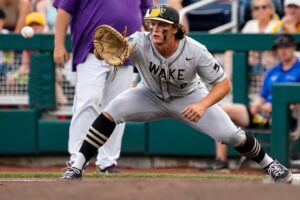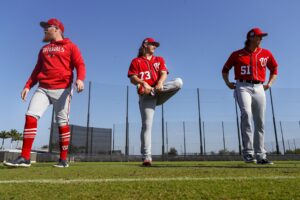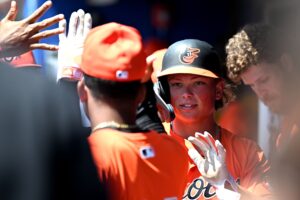The Hard-Luck Trade History of Doyle Alexander
“Whom did the Atlanta Braves trade to get John Smoltz?” Most serious baseball fans know the answer to this question is pitcher Doyle Alexander. Many use this as a punchline against the Detroit Tigers, the team who gave up Smoltz. Few, however, know that Alexander was once traded for another Hall of Famer. Even fewer know that he was traded seven times. Fewer still know that Alexander was good luck – good luck, that is, for teams who traded him away.
Trade Number One: Doyle Alexander and Three Prospects for Frank Robinson and Pete Richert
Doyle Alexander entered professional baseball in 1968 when the Los Angeles Dodgers selected him in the ninth round of the June Amateur Draft. This draft produced several bigger names, such as Thurman Munson, Greg Luzinski, Gary Matthews, Bill Buckner, Burt Hooton, Cecil Cooper, Steve Stone, and Paul Splittorff. For a young pitcher from Woodlawn High School in Birmingham, Alabama to go to the Dodgers, with their pitching coaches, had to be a dream come true.
Alexander spent three and a half seasons in the minors before making his major league debut on June 26, 1971. He had an average rookie season, going 6-6 with a 3.80 ERA, 115 ERA-, and a 1.332 WHIP in 92 1/3 innings. After the season, the Baltimore Orioles sent veteran reliever Pete Richert and 36-year-old right fielder Frank Robinson – a future Hall of Famer – to the Dodgers in exchange for Alexander and three prospects.
The Orioles missed the playoffs for the first time in the Divisional Era in 1972, finishing five games behind the AL East Champions, the Detroit Tigers. In 1973, they won the division again, with Alexander having a year that was slightly above average. He benefited heavily from run support – 5.6 per nine innings. This gave him a 12-8 record despite a 3.90 ERA (103 ERA-) and 1.307 WHIP in his starts (3.86/102/1.265 overall). Alexander had his first playoff start in the decisive Game Five, where he gave up three runs (two earned) on five hits in three and two-thirds innings. Jim Palmer relieved him and blanked the Oakland Athletics the rest of the way, but the Orioles lost, 3-0, thanks to a complete-game shutout by Catfish Hunter.
Second Trade: Doyle Alexander, Ken Holtzman, Grant Jackson, Elrod Hendricks, and a prospect for Rudy May, Tippy Martinez, Dave Pagan, Scott McGregor, and Rick Dempsey
After two and a half more seasons of so-so pitching, the Orioles sent Alexander to New York in a blockbuster. Minutes before the trade deadline, with the 26-31 Orioles languishing in fourth place – eight games behind the first-place Yankees – they pulled off the deal. They sent Alexander, pitchers Ken Holtzman and Grant Jackson, catcher Elrod Hendricks, and minor league pitcher Jimmy Freeman to the Yankees in exchange for pitchers Rudy May, Tippy Martinez, Dave Pagan, and Scott McGregor plus catcher Rick Dempsey. Martinez, McGregor, and Dempsey all played key roles when the Orioles won the pennant in 1979 and World Series in 1983, with Dempsey as the World Series MVP.
The trade helped both teams. Baltimore went 63-43 afterwards, vaulting them to second place with an 88-74 record. However, the Yankees went 65-40 over the same stretch, keeping hold of first place with a 97-62 record. Alexander helped the Yankees down the stretch, going 10-5 with a 3.29 ERA, 94 ERA-, and 1.120 WHIP. His record could have been even better – four times, he left the game in position to get the win only to have a reliever lose the lead.
The Yankees won the 1976 ALCS in five games over the Kansas City Royals, ending famously with a walk-off home run by Chris Chambliss. Alexander did not pitch in the series. He started Game One of the World Series against the Cincinnati Reds, getting shelled in the process. In six innings, he allowed five earned runs on nine hits and two walks. Ultimately, the Reds swept the Yankees to win their second straight World Series title.
Third Trade: With Larvell Blanks and Cash for Adrian Devine and Pepe Frias
Doyle Alexander signed a five-year, $750,000 deal with the Texas Rangers in the winter of 1976. His stint was mediocre. After three seasons, the Rangers traded him. On December 6, 1979 they sent Alexander to the Atlanta Braves along with Larvell Blanks and some cash to cover his contract in exchange for Adrian Devine and Pepe Frias. Of the other three involved in the trade, only Alexander and Frias lasted beyond the 1980 season, and Frias didn’t make it past 1981.
In Atlanta, he continued his mediocrity, going 14-11 in 1980 with a 4.20 ERA (109 ERA-) and 1.299 WHIP.
Fourth Trade: For John “The Count of” Montefusco and a Prospect
That December, the Braves shipped Doyle Alexander to the San Francisco Giants for a minor-leaguer who never made the majors and pitcher John Montefusco, the 1975 NL Rookie of the Year. Two years later, the Braves won the NL West for the first time since 1969.
In San Francisco, Alexander had a solid season, going 11-7 with a 2.89 ERA (85 ERA-) despite a 1.313 WHIP. The Giants barely missed the postseason in 1981, finishing three and a half games behind the Houston Astros in the second half of the year that was interrupted by a strike.
In a funny coincidence, Alexander’s manager in San Francisco was none other than Frank Robinson.
Fifth Trade: Doyle Alexander for Andy McGaffigan and Ted Wilborn
Just before the 1982 season, the Giants sent Alexander, who had yet to sign a contract, to the Yankees in exchange for Andy McGaffigan and Ted Wilborn. Neither panned out for the Giants. The Yankees had won the 1981 pennant but lost the World Series in six games to the Dodgers. They brought Alexander back to the team, hoping to get another title, and signed him to a four-year, $2.2 million contract.
Alexander’s second stint with the Yankees was a disaster. In his third start – Gaylord Perry’s 300th victory – he lasted three innings. After leaving the game he punched the dugout wall in anger, breaking his pinky and missing two months. He returned in July, pitching horribly in his first start back. This got him sent to Triple-A for rehab. That also did not go well. He went back to New York and struggled the rest of the season. His overall post-injury stats as a starter for the 1982 season: 1-5, 8.31 ERA (208 ERA-), 10 home runs allowed, and a 1.760 WHIP in 34 2/3 innings.
After a horrendous start to 1983, the Yankees released him on May 31. On June 21, the Toronto Blue Jays took a chance and signed him. He had a so-so rest of the season, putting up a 6-6 record in 15 starts with a 4.25 ERA (98 ERA-) and 1.321 WHIP in 106 innings.
Signing with the Blue Jays
Doyle Alexander pitched well in Toronto, helping them to a second-place finish in 1984 and a 99-62 record in 1985. The latter won the AL East and put the Blue Jays in the ALCS against the Royals.
In Game Three of the ALCS, Alexander took the mound with the Blue Jays holding a 2-0 series lead. The Royals lit him up, tagging him for five runs on seven hits in only five innings. Alexander surrendered three home runs – two by George Brett and one by Jim Sundberg. The Royals ultimately won, 6-5.
Toronto won Game Four to take a 3-1 series lead but lost Game Five to send the series back to Toronto. Alexander took the mound in Game Six with a chance to give the Blue Jays their first pennant. He did not survive the sixth, allowing five runs on seven hits, three walks, and another home run by Brett. The Royals won, 5-3, to force a Game Seven – one that they won, 6-2, en route to their first World Series title. In the process, the Blue Jays became the first team ever to blow a 3-1 series lead in LCS play. (It was also the first year that the LCS was best of seven, but still – they were the first to do it.)
Sixth Trade: Duane Ward
Doyle Alexander had a mediocre start to the 1986 season. On July 6, the fourth-place Braves were 41-40, three and a half games behind the Giants for first. They sent a young reliever, Duane Ward, to the 43-40 Blue Jays in exchange for Alexander. The hope was that Alexander would give the Braves the boost they needed to win the division. Instead, he was, like most of his career, mediocre.
After the trade, the Blue Jays went 43-36 to go 86-76 on the season and finish fourth in the AL East, nine and a half games out of first. The Braves went 31-49 after the trade, making their overall record 72-89 – dead last in the NL West, 23 1/2 games behind the division-winning Astros. Duane Ward ended up being a key member of the Blue Jays relief corps during their back-to-back World Series championships in 1992 and 1993. He was the set-up man in ‘92 and the closer in ‘93.
Seventh Trade: John Smoltz
The 1987 season saw another mediocre start by Alexander and an atrocious start by the Braves. On August 12, the Braves were 49-63 and in sixth place, nine games out of first. The Tigers were 64-46, a game and a half behind the Blue Jays for first in the AL East.
Atlanta, in full rebuild mode, sent Alexander to Detroit in exchange for a 19-year-old Double-A pitcher, future Hall of Famer John Smoltz. To fill Alexander’s spot in the rotation, the Braves promoted a Triple-A pitcher – future Hall of Famer Tom Glavine. In seasons where both were on the team, the Braves won 13 division titles, four pennants, and one World Series.
Alexander pitched the best baseball of his career down the stretch for the Tigers in 1987. He started 11 games, going 9-0 with a 1.53 ERA (36 ERA-), three home runs allowed, and a 1.008 WHIP in 88 1/3 innings. Led by Alexander, the Tigers went 33-18 down the stretch to roar into first, winning the loaded AL East by two games over the Blue Jays.
The 98-64 Tigers went into the ALCS as heavy favorites over the 85-77 Minnesota Twins. Alexander started Game One in the Metrodome, entering the bottom of the eighth with a 5-4 lead before falling apart. He ended up allowing six runs, all earned, on eight hits and two home runs in 7 1/3 innings en route to an 8-5 Twins victory. Alexander then started Game Five in Tiger Stadium, with the Tigers facing a 3-1 series deficit. He did not survive the second, as the Twins teed off on him for four runs, all earned, on six hits in 1 2/3 innings. It ended up being the last postseason game for both Alexander and Tiger Stadium.
In Review
Doyle Alexander lasted two more seasons after that, putting up mediocre numbers in both. He made the AL All-Star team for the only time in his career in 1988. However, he did not play in the game. The AL won, 2-1, to start a six-game All-Star winning streak. This was coincidental, but after seeing the luck of the rest of his career, it doesn’t feel like it.
In summation, Alexander was traded seven times. In his first and last, he went in exchange for a future Hall of Famer – Robinson and Smoltz. Two of the players who went the other way in his trades were former Rookies of the Year – Robinson and Montefusco. Three teams who traded him – the Orioles, Blue Jays, and Braves – later won the World Series with one or more of the players they received in return. The Orioles even received the MVP of said series in the trade. Six All-Stars also went the other way in his trades – three who had already made the team (Richert, Robinson, Montefusco) and three who later did (McGregor, Ward, Smoltz).
All this in return for Doyle Alexander, a slightly above-average pitcher who made one All-Star team in his 19-year career. He was a guy whose postseason record was abysmal – 0-5 with an 8.38 ERA, seven home runs, a 1.655 WHIP, and 29 innings in six games, all starts. No team ever won a playoff series in which he played. It seems like a high price to pay for mediocrity.
(Author’s Note: I did not include his strikeout and walk totals because he was a contact pitcher — both were exceedingly low.)
Main Photo
Embed from Getty Images






